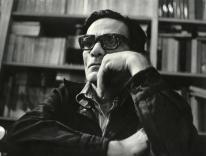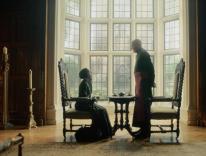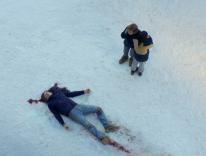The current boom in comic-book-based movies is partly technological. Yet in addition to providing a vehicle for digital wizardry, comics offer us a view of our collective self, revealing the underlying urgencies of the moment. And while recent movies made from comics (and graphic novels) include such offbeat productions as Ghost World and American Splendor, the bigger productions-The Hulk, Spider-Man, Daredevil-continue to stake out the classic American terrain where sci-fi meets action hero. It’s a terrain where wildly divergent evocations of American maleness under duress focus a question as timely now as ever: Who are we when we resort to violence?
The Punisher opens with a high-speed montage of images from the Marvel Comics original, with a slo-mo hail of bullets and shell casings triggering a black-and-white seep of blood that melts into the skyline silhouette of (it turns out) Tampa. The story follows an undercover FBI agent, Frank Castle (Tom Jane), whose sting operation against a drug-and-arms ring ends up killing the son of a moneylaundering nightclub owner, Howard Saint (John Travolta). Spurred on by his vicious wife, Saint enacts a murderous revenge against Castle’s family.
Comics establish a zone in which morality can be drawn with, well, comic-book clarity, and villainy relished for its dire purity. When we first see the palatial Saint residence, the mansion fairly vibrates with vile South Florida extravagance, as the soundtrack plays ominously along. Later on, Saint convenes a conference of hit men, and they’re dressed all in black and wearing dark sunglasses. (They’re either the most audacious group of villains ever assembled, or the editorial staff of Tina Brown’s latest magazine.) Other scenes take off on Westerns, like a face-off in a corporate office building that pits Castle against two thugs, all three in greatcoats, fingers twitching on their holsters.
Such tongue-in-cheek stylizations could be enjoyable, but director Jonathan Hensleigh isn’t out for humor. A grim realism keeps dragging his movie down, and an undercurrent of nastiness grows gooier as the bodies float past. The original Punisher comic dates to 1974, heyday of the Charles Bronson Death Wish films-urban revenge movies in which Bronson’s mild-mannered architect becomes a remorseless vigilante after his family is slaughtered by thugs-and the setup here is identical. When we see Castle relaxing in a Caribbean paradise with his family (“You and I,” his wife coos, “we’re blessed”), we know what is coming. And when it does, it’s awful, a beachfront massacre portrayed in horrific detail.
The remainder of the movie is devoted to ecstasies of vengeance. Rechristened in blood as the Punisher, Castle returns the violence visited upon his family tenfold, using every imaginable weapon to slice, puncture, scald, scalp, garrot, and skewer the bad guys. Hensleigh captures these torments with the relentless solemnity of a pornographer, earnestly fixated on the money shots, so that by film’s end, when the apocalyptic urban firestorm Castle has ignited morphs surreally into the skull shape of the Punisher logo, it’s a shock to recall that we’re in a comic.
From a distance of thirty years, it’s easy to see what the Death Wish movies of the 1970s were about. They vented an ugly feeling of middle-class rage: at inflation’s bankrupting of the American dream; at the parlous condition of the cities and law enforcement’s haplessness in the face of violent urban crime. But why do we need the Punisher in 2004, with New York City resurgent, interest rates at historic lows, and urban crime so drastically reduced that police forces everywhere clamor for credit?
My guess is that the Punisher’s new relevance lies not in crimefighting, but in crimefighting’s military cousin. Castle, we learn, is a Special Forces veteran, and with his chiseled GI-Joe face, dangling dog tags and cut physique he looks every bit the part. For a superhero he is anomalous; he possesses no super powers, just courage, a vast arsenal of weapons, and an annihilating rage to kill. And his killing comes with a philosophical commentary. “Sometimes the law is inadequate,” he muses, “and you have to act outside it.” “If you want peace, prepare for war.” “Those who do evil to others...will come to know me well.” With these pronouncements a steely-jawed, heavily armed man takes brutal action to punish “the evildoers” for spilling innocent American blood.
Talk about an intrusion of grim reality.
What a relief, then, to relax back into Hellboy, Guillermo del Toro’s sympathetic adaptation of the Dark Horse comic spawned in the mind of Mike Mignola. The occult origins of the tale lie in a fantastic collaboration of evil. Near the end of WWII, as GIs close in, a team of fanatical Nazis joins up with the Russian monk Rasputin-it seems he never really died-in a last-ditch hi-tech attempt to open a portal to hell and unleash some monstrosity to save the day for evil. Unfortunately for them, what comes scooting through the portal, while red and horned, isn’t the Devil, but a loveable little fellow with an oversized stone mitt for a right hand, who craves Baby Ruth bars and longs to be cuddled. Hellboy, the GIs who find him fondly christen him.
Flash forward to present-day New York and the ultrasecret Bureau for Paranormal Research and Defense, lodged in a high-modernist stone temple in, of all places, Newark. Here Hellboy himself (Ron Perlman), now almost sixty-in demon years, apparently, still just a young guy-lives with his father figure and discoverer, the aged Professor Trevor Broom (John Hurt), and a motley crew of other fantastic beings whose existence the government denies even as it avails itself of their help in fighting evil. They include a friendly fish-man named Abe (Doug Jones), and the pyrotelekinetic Liz (Selma Blair), a sultry cutie who bursts into flame when provoked, and for whom Hellboy, well, has the hots. When the seemingly unkillable Rasputin and his mysteriously reconstituted Nazi pals show up for more, Hellboy and company are called upon to give it to them.
Like the Punisher, Hellboy is an unlikely superhero, but in the opposite way-a sweet-souled, if brash-talking, adolescent, lost inside a massive muscled frame. Director del Toro has shrewdly mined the dark gothic expressionism of Mignola’s comic with counter-charges of irreverence and fun. Every morning Hellboy takes an electric grinder to his horns-“he files them,” an FBI agent explains, “to fit in.” In his locked underground apartment at the Bureau, he sits eating vast quantities of nachos and pancakes, listening to Al Green, and penning hopeless love notes to Liz. As one witty film reviewer remarked, most heroes need a cape, but Hellboy needs a hug.
Hellboy takes us to extravagant places of doom replete with giant geared contraptions, blazing electromagnetic whirligigs, and daggers that shoot out from walls and floors: a haunted-house look that is pure fun. And the violence plays along. When faced with a fiendish hound of hell unloosed by Rasputin, a slavering creature resembling a cross between a Gorgon and a giant squid, who moreover has just finished munching a bushel of security guards, Hellboy tosses off a spry taunt: “Hey Stinky-kitchen’s closed!” After dispatching the beast with weary revulsion-just doing his job, he insists-he grabs a six-pack of Bud and heads out to woo Liz yet again.
Mignola has called the Hellboy persona a tribute to his father, a builder who would come home bleeding from a workplace accident and shrug it off with a bluff, “Oh yeah, I got my hand stuck in a machine.” No ringing pronouncements about justice here, just the daily heroism of the American working man, who gets the job done even when it’s dirty and unglamorous. Where Punisher traces to the curdled disaffection of the 1970s, the character of Hellboy looks back to an earlier, far more optimistic era. He is the American man at midcentury-the big lug of a GI, whose brash humor posed American innocence against fascism, facing evil’s demand to capitulate and shouting back, Nuts! This was an American archetype in whom strength was tempered by deep gentleness, and violence arose as a reluctant last resort. Maybe this explains why audiences have warmed so to Hellboy: in him we hear the echo of our best self.
Please email comments to [email protected] and join the conversation on our Facebook page.
Share
Previous Story
Informal Fallacy
Next Story
Air America


